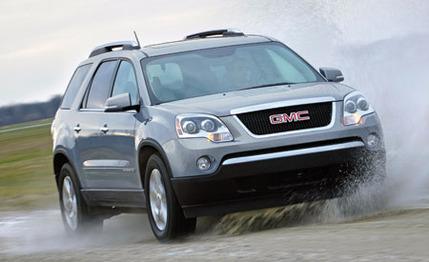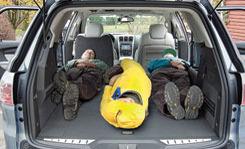
 Road Test
Road Test
Okay, what's this about a shorter name? And who the hell is this Evangeline?
Listen up. GMC, which dates to 1909, was formerly GMC Truck — appropriate, since that's what this General Motors division made: trucks and buses. The story goes back even farther, to the Rapid Motor Vehicle Company, one of America's first commercial-vehicle concerns, established in 1901 by Max Grabowsky and sold to GM in 1909. So if you sort of forgot about GMC's dropping the Truck part on becoming part of the Greater Pontiac Co-Prosperity Sphere in 1996, don't worry. We did, too.
In any case, the change was fortuitous, because the Acadia is not a truck. Not in the traditional body-on-frame truck sense. It looks sorta like a truck, and the EPA calls it a truck, but the bones are front-drive unibody. They call it the Lambda architecture, designed for GM's big new front-drive utility vehicles. The result is one of those new-breed rides we call crossovers — neither car nor truck, and a first for GMC.
And what does Evangeline have to do with this? American lit majors may recall Evangeline Bellefontaine as the sad heroine of the 1847 epic poem by Henry Wadsworth Longfellow, a lost-love story about the 1755 expulsion of the French-speaking population of Acadia (now known as Nova Scotia) during the French and Indian wars.
Separated from her boyfriend, Gabriel Lajeunesse, when the Redcoats herded the Acadians onto transports, Evangeline wound up in Louisiana and spent the rest of her life trying to reconnect with Gabriel. And even though she was a fictional figure, she has come to be regarded as the original queen of the Cajuns. (Acadians.Cajuns. Get it?)
Folklore aside, why do we think Evangeline would favor this ride if she were around today? Easy. Instead of pining, she would have Googled up Gabriel, they would have reconnected, and a batch of soccer-playing Cajun kids would have ensued. Being entirely too cool to be seen in something as mundane as a minivan, Evangeline would have opted for something like this.
That's the essence of this new GM line, which includes the Saturn Outlook, with the Buick Enclave due next fall. Although these new vehicles lack sliding doors and have more ground clearance, they serve essentially the same function as minivans. They have to serve that function, because GM, like Ford, is giving up on minivans. So you can forget about the Buick Terraza, Chevy Uplander, and Saturn Relay. Which should be pretty easy.
Okay, minivan usefulness, truckish macho, what else? Let's start with a size perspective. At 201.1 inches long, the Acadia is within an inch of the Yukon, GMC's traditional full-size ute. It's not as tall (72.7 inches versus 76.9), but the two vehicles are essentially identical in width (78.9 versus 79.0). The Acadia's 118.9-inch wheelbase is 2.9 inches longer than the Yukon's, a plus for ride quality, as well as an opportunity for the design team to maximize interior space for people, cargo, or both. The ability to ingest mass quantities is an Acadia strong suit. With both rows of rear seats folded flat, the capacity is 117 cubic feet, compared with 109 for the larger Yukon.


To be fair, most minivans have more cargo capacity than this, but they don't have the Acadia's ground clearance (7.4 inches) or towing capacity: with the Trailering package (primarily a bigger radiator) it's rated to drag a trailer weighing up to 4500 pounds. Body-on-frame SUVs have a clear advantage in this area — half-ton Yukon trailering limits range between 7500 and 8200 pounds, but 4500 is pretty good for a unibodied vehicle that's primarily a front-driver. The basic trailering capability for the Honda Pilot, for example, is 3500 pounds.
Why draw comparisons with the Pilot? Because the Pilot was the key benchmark for GM's new Lambda utes. That's interesting, because even though the Pilot is a three-row vehicle, it's smaller than the Acadia in every dimension, as well as at the scales. The last Pilot we tested ["Battle of the Neither-Nors," C/D, April 2003] weighed 4341 pounds. Our all-wheel-drive Acadia scaled in at a hefty 5052. Then again, that's 788 fewer pounds than the Yukon-clone Chevy Tahoe we tested in February.
Interpreting from the finished product, the Acadia design charter seems to have been to duplicate the Pilot's excellent ergonomics, build quality, and nimble (by SUV standards) dynamics on a larger scale. We have to say mission accomplished. The Acadia's responses are, inevitably, tempered by its mass, but those responses measure up as exceptional among vehicles in this size class.